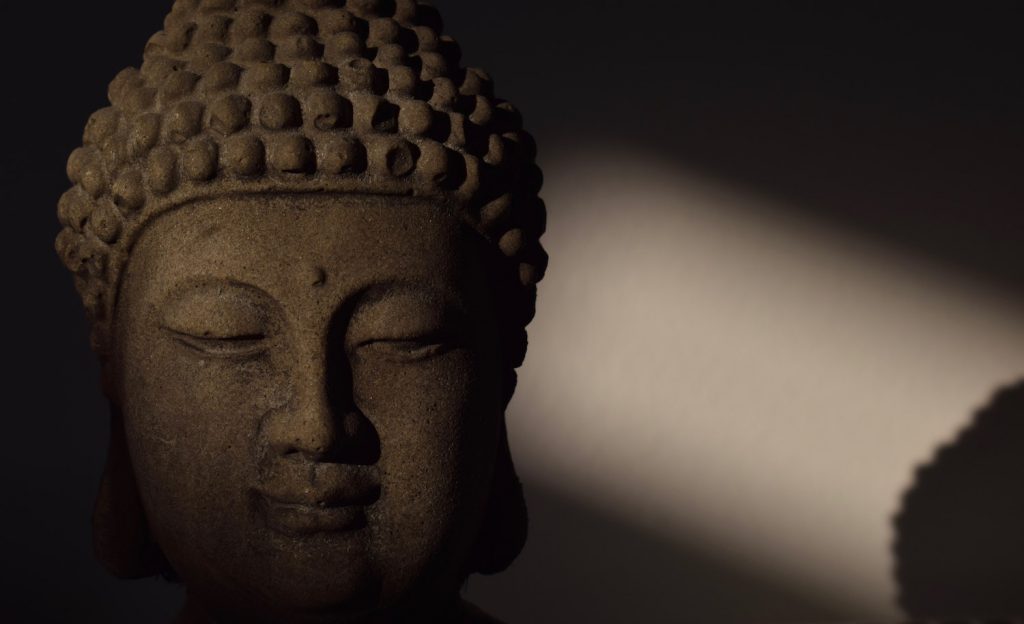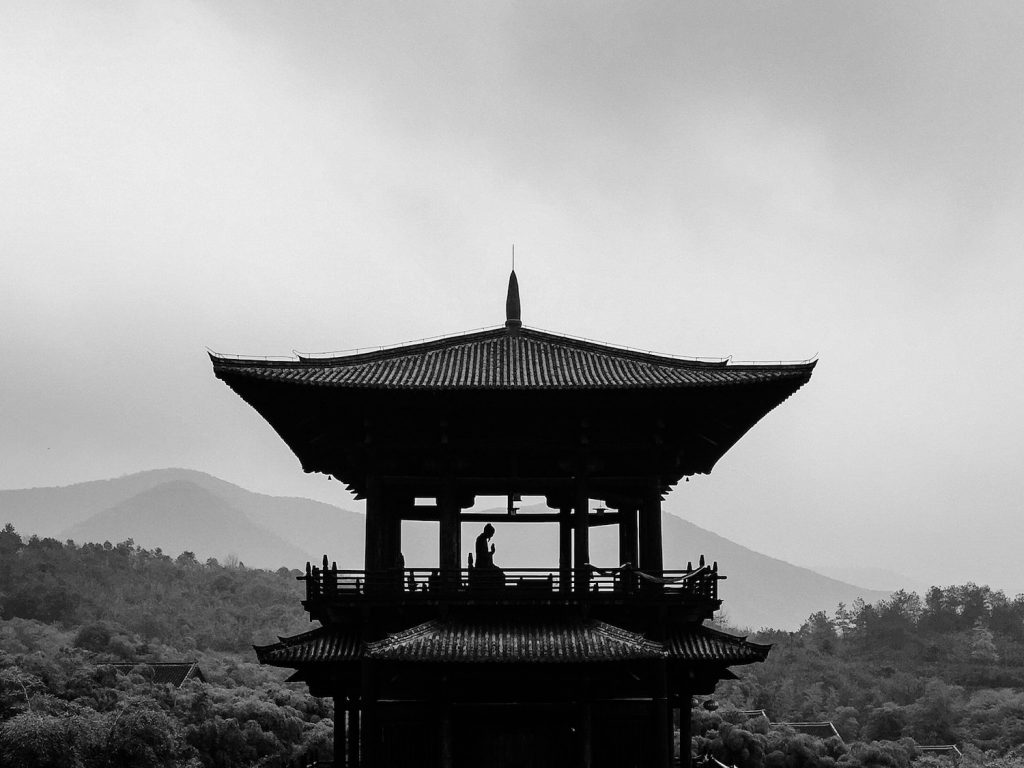Evaluating Antinomianism in Jodo Shu Buddhism
by Abigail Clark

This paper deals with the concept of antinomianism within the Jodo Shu sect of Buddhism, the Japanese form of Pure Land Buddhism. I discuss this sect’s origin in detail, specifically with its founder Honen and his life leading up to establishing the central concept surrounding the Jodo Shu, the nembutsu. Honen pioneered the practice of the nembutsu, the term used to refer to a repeated phrase which pays homage to the deity Amitabha. This phrase supposedly took followers to a heavenly realm known as the pure land after death, and it held the power to take followers there despite moral breaches. Because of this notion, many claimed the belief to be reminiscent of antinomianism. The paper discusses this topic and the varying arguments surrounding it, including the scrutiny of Honen and his followers during the day, scholars’ claims of antinomianism, and the defense against such claims. The author’s aim, with the evaluation of all these arguments, is to highlight the topic’s nuances and complexities. These complexities reveal the importance of evaluating issues from various angles. To discuss a complex topic simply without diving into its layers is to evaluate it not at all.
KEY WORDS: Jodo Shu Buddhism, Pure Land Buddhism, antinomianism, nembutsu
Established by the famous Buddhist figure Honen, the sect of Pure Land Buddhism known as Jodo Shu, recognized as the first independent school of Pure Land Buddhism in Japan, has a rich historical foundation (Hattori). Saturated with captivating doctrinal themes and connotations, the origin story of the Jodo Shu begs for in-depth discussion and analysis. Like nearly any historical narrative, simply telling an unnuanced story would be a serious injustice.
Of course, some would argue that serious injustices are not a concern within the Jodo Shu school. One of the most interesting topics raised concerning Jodo Shu beliefs is the concept of antinomianism. According to Legalism, Antinomianism, Situationism: Three Moral Decision-Making Orientations, antinomianism is defined as “the approach with which one enters into the decision-making situation armed with no principles or maxims whatsoever, to say nothing of rules. In every ‘existential moment’ or ‘unique’ situation, it declares, one must rely upon the situation of itself, there and then, to provide its ethical solution” (Gillmore and Hunter 3).
Due to the nature of its history and doctrine, the Jodo Shu sect of Buddhism has faced claims of antinomianism. The purpose of this paper is not to make a conclusive statement on whether the Jodo Shu sect of Buddhism was “guilty” of such claims; rather, it is to examine relevant information from various lenses and to underscore the fact that this topic is far from black and white. Various social, doctrinal, and psychological factors reveal nuances and layers that must be acknowledged to do the topic justice. Before further discussion, however, it is necessary to summarize the story of Honen and his establishment of Jodo Shu doctrine.
Honen’s early exposure to monastic life likely begot his significant role in the development of Buddhism. Suddenly orphaned at the age of thirteen, he joined the Mt. Hiei monastery and became completely immersed in Tendai practice at a young age (Kaneko and Sakamoto 54). It is said that Honen read the entire Buddhist canon at least three times during his time at the monastery but that he found no enlightenment from the practice (Kaneko and Sakamoto 53; Lopez 611). However, after reading a commentary on the Visualization Sutra, Honen left Mt. Hiei at forty-two years old (Amstutz 7). Based on his extensive studies of Buddhist texts, he concluded that the world had reached the “degenerate age,” an age in which the chances of reaching enlightenment were impossible except by chanting the name of the buddha Amitabha (Lopez 611-612). The recited phrase commonly referred to as the nembutsu is used to call on the power of Amitabha for salvation (Lopez A6). The nembutsu involves reciting the phrase namu amida butsu, which means “Homage to Amitabha” (Lopez A6). This became the central and sole tenant of the Jodo Shu tradition.
namu amida butsu, namu amida butsu, namu amida butsu, namu amida butsu
Not unlike many emerging religious traditions that challenge societal order, Honen and his followers faced adversity. Claiming that the nembutsu was the only practice necessary for achieving rebirth in the Pure Land challenged established monastic practices: “His ideas threatened other sects, especially the Tendai” (Fodor’s Pocket Kyoto 26). In Interpreting Amida: History and Orientalism in the Study of Pure Land Buddhism, Galen Amstutz argues that the degree to which Honen challenged the monastic practices of the day was very significant. He argues that Honen and his disciples catalyzed a change in the landscape of East Asian Buddhism, structured with monasticism at its center and lay practices in the periphery: “Honen initiated radical change in East Asian Buddhism by rediscovering the possibility of independence from the monastic mythos” (Amstutz 7). Amstutz even goes so far as to say that “Honen declared monastic practice completely illegitimate” and “the idea of the minimal practice pushed the necessity of monastic practice further to the side than it had ever been pushed in Japan” (Amstutz 7-8). Thus, it cannot be denied that the introduction of the nembutsu challenged the social order of the day.
While the nature of such emphasis on the nembutsu implies an attack on the monastic order at the time, it also has other doctrinal connotations. If simply reciting the nembutsu allows anyone, even the greatest sinner, to go to the Pure Land, then followers of the Jodo Shu could potentially justify evil acts. If the grace of Amitabha is sufficient to save anyone, it seems to suggest that followers have a license to sin. In Mahayna Buddhism: The Doctrinal Foundations, Paul Williams touches on this concept. He says, “Honen’s teaching that the nembutsu is sufficient for salvation, and Amitabha saves even the lowest sinner, was open to charges of antinomianism” (Williams 267). Williams summarizes the argument for antinomianism in the Jodo Shu school by saying that followers may feel as though they can be evil or act however they choose, no matter the ethical implication, because Amitabha will save them anyway. In this piece, Williams also brings up another accusation made by Myoe Shonin, a scholar in the Kegon school. Shonin criticized Honen’s teaching to be so far from orthodoxy that it was “in fact not Buddhism…just the non-Buddhist search for heaven in another guise” (Williams 267).
It is clear that Honen’s teachings stirred controversy in the community in more ways than one. Due to the nature of the Jodo Shu doctrine outlined in the paragraphs above, it is no surprise the monastic community was very displeased: “It is clear that Honen’s circle gradually attracted the unfriendly attention of the large monastic establishments, especially Mt. Hiei, which submitted a petition to the emperor in 1204 which alleged dangerous antinomian and unconventional qualities in Honen’s teaching” (Amstutz 8). A scandal involving a few of Honen’s disciples exacerbated the issue and added intriguing nuances to this antinomianism accusation. This incident, described with slight variations by different sources, resulted in the execution of four disciples and the exile of several others, including Honen (Amstutz 8). Lopez describes the incident in the following manner: “Two of [Honen’s] monks, known for their beautiful chanting, were invited to court and ended up spending the night in the ladies’ quarters” (Lopez 612). Amstutz describes it as a “scandal involving women in the emperor’s palace… a personal breach of faith,” while Fodor’s Pocket Kyoto records that “two of the emperor’s concubines became nuns after hearing some of Honen’s disciples preaching. The incident provided [the emperor] with an excuse to decry the Jodo sect as immoral, with the charge that its priests were seducing noblewomen” (Amstutz 8; Fodor’s Pocket Kyoto 26). All in all, it can be concluded from the execution and exile that the acts in which Honen’s followers engaged broke moral codes. For those studying the doctrine of the Jodo Shu, this scandal puts a megaphone to the voice of antinomianism claims.

As discussed previously, the concerns of the Jodo Shu have to do with its acceptance of even the worst sinners into the Pure Land, in addition to the focus that the doctrine puts on the search for rebirth and heaven. This is an issue because it has the potential to take away from the development of other important Buddhist values, such as compassion and detachment. While Honen himself was exiled because of the turmoil his teachings brought into the community, many of his personal beliefs seem to indicate that the way in which he went about his teaching emphasized striving for moral behavior.
Many sources outline ways that Honen discouraged his followers to use the nembutsu teaching as a license for evil. Lopez explicitly states that “[Honen] also stressed the importance of ethical practice, saying that if a wicked man can be reborn in the Pure Land, a good man has a far better chance” (Lopez 612). In The Meaning of Salvation in the Doctrine of Pure Land Buddhism, Kaneko and Sakamoto also refute the criticism that the Jodo Shu places too large an emphasis on rebirth and heaven, arguing that the “deteriorated and secularized” Pure Land cult is guilty of this but that genuine Pure Land faith is not (Kaneko and Sakamoto 54). The authors go on to argue that the development of Honen’s beliefs came out of his desire to confront the universal issue of “the sinfulness of man,” seeking to create a doctrine in which the salvation of humans from the cycle of suffering is the main concern: “This concern is really furthest from the ego-centric desire for happiness and enjoyment. The spirit of Mahayana Buddhism which emphasizes ‘seeking Enlightenment together with all fellow beings’ is most vitally and thoroughly embodied in Pure Land Buddhism” (Kaneko and Sakamoto 54). In Beacons of Light: 100 Holy People Who Have Shaped the History of Humanity, Marcus Braybrooke presents the following strong, pointed statement: “[Honen’s] enemies argued that such emphasis on the unconditional mercy of the Divine can be perverted into an excuse for lawless behavior, often called antinomianism. Honen clearly rejected this” (Braybrooke 270). These arguments emphasize the notion that, though Honen’s doctrine of the Jodo Shu may have resulted in the immoral behavior of his disciples, Honen’s personal convictions did not directly propagate such behavior; according to some, he explicitly denounced it.
Nonetheless, it must be recognized that many of Honen’s expressed beliefs are seemingly contradictory. For example, Honen held the central belief that chanting the nembutsu removes the effect of sin but also expressed in other instances that, if one chants the nembutsu with a “wrong spirit” at death, it will do nothing to get one into the Pure Land.. For this reason, Williams expresses that, while Honen made a name for himself and was greatly influential in Japanese Buddhism, he was not the most “systematic thinker.” He continues, “His utterances should be seen as individual responses to the specific problems of his followers, and his age” (Williams 268). While Honen’s intentions may have been to uphold ethical practices, these inconsistencies in beliefs may have caused confusion among followers and could have potentially contributed to antinomian tendencies among those followers who engaged in immoral behavior.
One could also argue that the executed monks who practiced the Jodo Shu and engaged in immoral behavior were not necessarily blind to moral principles but just saw them as unimportant. This again brings up the idea that they saw the grace of Amitabha as so strong that it would have overridden any wrongdoing. If one defines antinomianism as a frame of decision-making that relies on no pre-existing ethical principles, the behavior of these individuals may not necessarily be textbook antinomianism, because they potentially recognized moral principles. It is also true that Honen explicitly recognized moral principles. However, those monks that did end up engaging in immoral behavior very well could have used Honen’s central teaching, the supremacy of the nembutsu and the overriding grace of Amitabha, to justify their actions.
One could even infer that some of the ways that Honen approached the nembutsu were legalistic. Though it is a simple practice, Honen was said to have chanted the nembutsu around 70,000 times per day (Lopez 613). As previously mentioned, he read the entire Buddhist canon three times when he was part of the Tendai tradition, before developing his Jodo Shu theology and its proposition that the nembutsu alone leads to salvation (Lopez 612). “His elaborate study of the sutras and sastras as well as his rigorous disciplinary practices for many years in the monastery on Mt. Hiei were exclusively devoted to the purpose of attaining that Dharma” (Kaneko and Sakamoto 53). These practices of intense dedication and focus do seem reminiscent of legalism.

One may argue that such legalism and extreme dedication to attaining the Dharma led him to frustration with the complexity of the Buddhist canon, resulting in the simplicity of his theology. This simplicity, potentially developed by his own frustration, morphed into dangerous practice when adopted by those disciples who took their belief in the grace of Amitabha to the extreme. In a text discussing the psychological conditions of conversion and the nembutsu, Yumiko Inukai discusses William James’s text, The Varieties of Religious Experience. James identifies religion as “the feelings, acts, and experiences of individual men in their solitude, so far as they apprehend themselves to stand in relation to whatever they may consider the divine” (Inukai 440). This definitely holds true in Honen’s development of the Jodo Shu, and it is clear how the psychological state of Honen, exhausted from spending the majority of his life in a monastery while failing to reach any breakthrough with his study, gave way to the simple yet radical principle of the nembutsu. It is interesting that a doctrine, perhaps born out of legalism and influenced heavily by the frustrated psychological state of its founder, evolved into practices that brought up claims of antinomianism and an eventual scandal which underscored such claims.
By examining the origin story of the Jodo Shu doctrine and the practice of the nembutsu, many interesting social, doctrinal, and psychological nuances become apparent. It is intriguing to see how the nature of Honen’s independent Pure Land doctrine gave way to claims of antinomianism, inflated by the scandal involving Honen’s followers. In studying Honen’s personal convictions and support for moral behavior, it becomes apparent that there is no straightforward explanation for whether Honen’s teaching should be blamed for the scandal. It is evident that many factors, including the threat that the nembutsu teaching posed to monastic society, in addition to the psychological state of Honen when he developed the doctrine, were at work throughout the narrative. Simply to write off the Jodo Shu as antinomian would do the doctrine a complete injustice; this foundational story of the Jodo Shu sheds a light on the importance of analyzing historical accounts through various lenses. Placing oneself within the context of this story and acknowledging all its moving parts allows one not only to gain a more holistic view of the doctrine but also to give it the depth of study it deserves.
Works Cited
Amstutz, Galen Dean. Interpreting Amida: History and Orientalism in the Study of Pure Land Buddhism. Albany: State University of New York Press, 1997.
Braybrooke, Marcus. Beacons of the Light: One Hundred People Who Have Shaped the Spiritual History of Humankind. John Hunt Publishing, 2009.
Fodor’s Travel Publications. Fodor’s Pocket Kyoto, edited by Deborah Kaufman. 1st ed., Random House, 2002.
Gillmore, Gerald M., and John E. Hunter. “Legalism, Antinomianism, Situationism: Three Moral Decision-Making Orientations.” Review of Religious Research, vol. 16, no. 1, 1974, pp. 2–9.
Hattori, Sho-on. A Raft From the Other Shore: Honen and The Way of Pure Land Buddhism. Tokyo: Jodu Shu Press, 2006.
Inukai, Yumiko. “Honen and James on Religious Transformation: Psychological Conditions of Conversion and the Nembutsu.” Philosophy East and West, vol. 62, no. 4, 2012, pp. 439-462.
Kaneko, Daiei, and Hiroshi Sakamoto. “The Meaning of Salvation in the Doctrine of Pure Land Buddhism.” The Eastern Buddhist, vol. 1, no. 1, 1965, pp. 48-63.
Lopez, Donald S. Buddhism. New York: W.W. Norton & Company, 2017.
Williams, Paul. Mahayana Buddhism: The Doctrinal Foundations. 2nd ed., New York: Routledge, 2009.
Acknowledgments: Dr. Marchman, professor of my East Asian religions class for which this paper was written